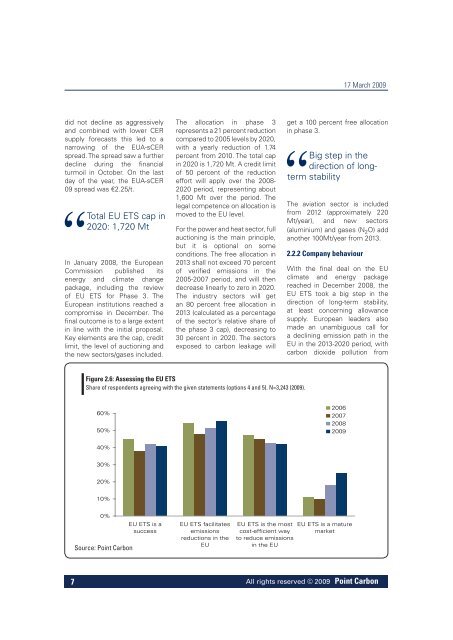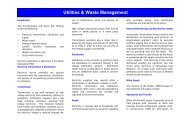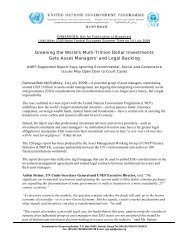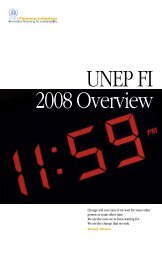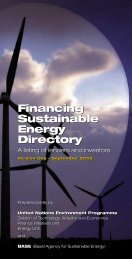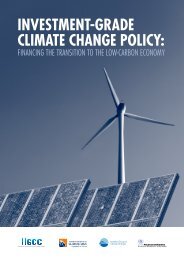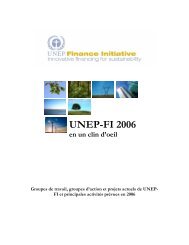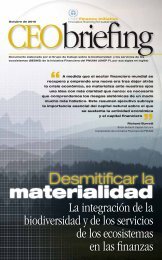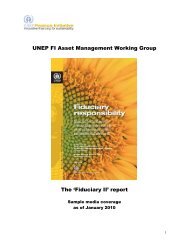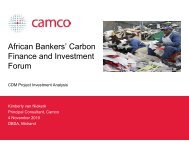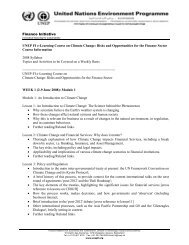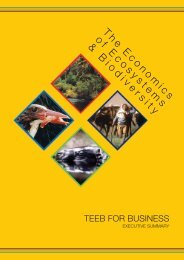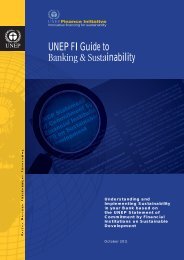Carbon 2009 Emission trading coming home - UNEP Finance Initiative
Carbon 2009 Emission trading coming home - UNEP Finance Initiative
Carbon 2009 Emission trading coming home - UNEP Finance Initiative
Create successful ePaper yourself
Turn your PDF publications into a flip-book with our unique Google optimized e-Paper software.
17 March <strong>2009</strong><br />
did not decline as aggressively<br />
and combined with lower CER<br />
supply forecasts this led to a<br />
narrowing of the EUA-sCER<br />
spread. The spread saw a further<br />
decline during the financial<br />
turmoil in October. On the last<br />
day of the year, the EUA-sCER<br />
09 spread was €2.25/t.<br />
Total EU ETS cap in<br />
2020: 1,720 Mt<br />
In January 2008, the European<br />
Commission published its<br />
energy and climate change<br />
package, including the review<br />
of EU ETS for Phase 3. The<br />
European institutions reached a<br />
compromise in December. The<br />
final outcome is to a large extent<br />
in line with the initial proposal.<br />
Key elements are the cap, credit<br />
limit, the level of auctioning and<br />
the new sectors/gases included.<br />
The allocation in phase 3<br />
represents a 21 percent reduction<br />
compared to 2005 levels by 2020,<br />
with a yearly reduction of 1.74<br />
percent from 2010. The total cap<br />
in 2020 is 1,720 Mt. A credit limit<br />
of 50 percent of the reduction<br />
effort will apply over the 2008-<br />
2020 period, representing about<br />
1,600 Mt over the period. The<br />
legal competence on allocation is<br />
moved to the EU level.<br />
For the power and heat sector, full<br />
auctioning is the main principle,<br />
but it is optional on some<br />
conditions. The free allocation in<br />
2013 shall not exceed 70 percent<br />
of verified emissions in the<br />
2005-2007 period, and will then<br />
decrease linearly to zero in 2020.<br />
The industry sectors will get<br />
an 80 percent free allocation in<br />
2013 (calculated as a percentage<br />
of the sector’s relative share of<br />
the phase 3 cap), decreasing to<br />
30 percent in 2020. The sectors<br />
exposed to carbon leakage will<br />
get a 100 percent free allocation<br />
in phase 3.<br />
Big step in the<br />
direction of longterm<br />
stability<br />
The aviation sector is included<br />
from 2012 (approximately 220<br />
Mt/year), and new sectors<br />
(aluminium) and gases (N 2 O) add<br />
another 100Mt/year from 2013.<br />
2.2.2 Company behaviour<br />
With the final deal on the EU<br />
climate and energy package<br />
reached in December 2008, the<br />
EU ETS took a big step in the<br />
direction of long-term stability,<br />
at least concerning allowance<br />
supply. European leaders also<br />
made an unambiguous call for<br />
a declining emission path in the<br />
EU in the 2013-2020 period, with<br />
carbon dioxide pollution from<br />
Figure 2.6: Assessing the EU ETS<br />
Share of respondents agreeing with the given statements (options 4 and 5). N=3,243 (<strong>2009</strong>).<br />
60%<br />
50%<br />
2006<br />
2007<br />
2008<br />
<strong>2009</strong><br />
40%<br />
30%<br />
20%<br />
10%<br />
0%<br />
Source: Point <strong>Carbon</strong><br />
EU ETS is a<br />
success<br />
EU ETS facilitates<br />
emissions<br />
reductions in the<br />
EU<br />
EU ETS is the most<br />
cost-efficient way<br />
to reduce emissions<br />
in the EU<br />
EU ETS is a mature<br />
market<br />
7<br />
All rights reserved © <strong>2009</strong> Point <strong>Carbon</strong>


